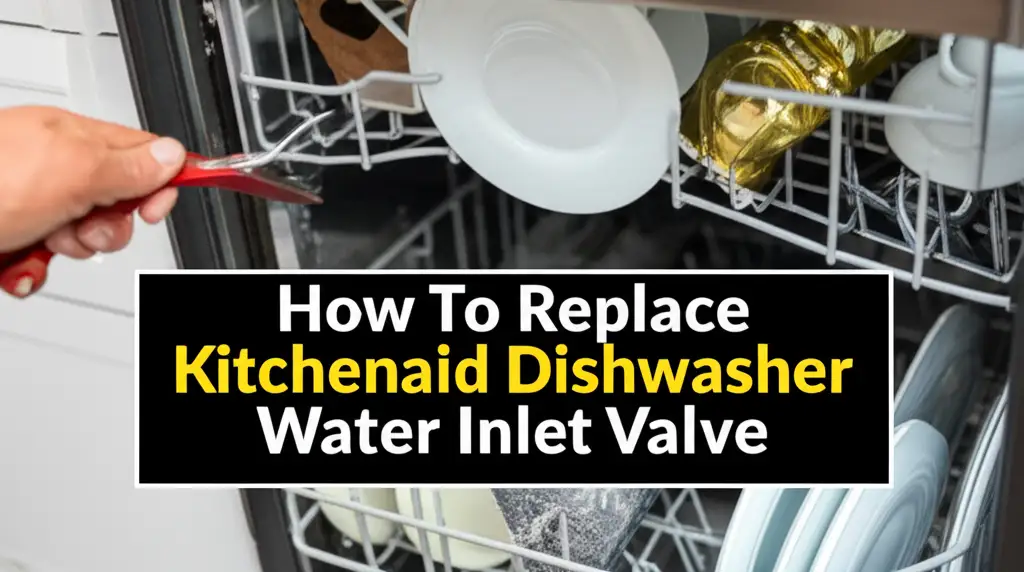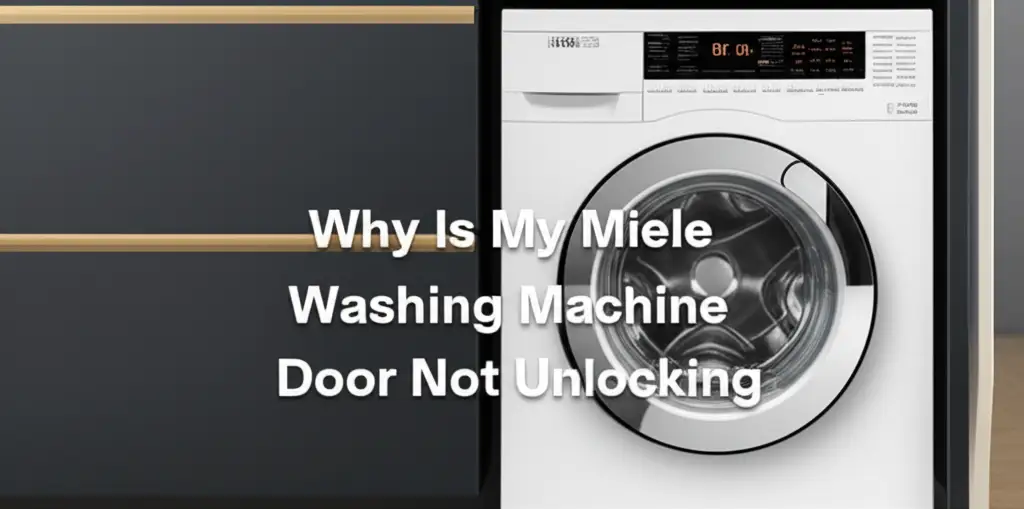· Todd Martin · Home Appliance Repair · 21 min read
How To Replace Kitchenaid Dishwasher Water Inlet Valve

Replacing Your KitchenAid Dishwasher Water Inlet Valve: A Complete Guide
A noisy KitchenAid dishwasher or one that fails to fill with water can cause frustration. Many times, the issue points to a faulty water inlet valve. This small but vital component controls water flow into your appliance. When it malfunctions, your dishwasher simply cannot do its job.
I understand how disruptive a broken dishwasher can be to your daily routine. Replacing the KitchenAid dishwasher water inlet valve may seem like a big job. However, with the right guidance, this is a repair you can handle yourself. This guide provides clear, step-by-step instructions. You will learn to diagnose the problem, gather necessary tools, and safely replace the valve. Let’s get your KitchenAid dishwasher running smoothly again.
Takeaway
Replacing your KitchenAid dishwasher water inlet valve is a manageable DIY task.
- Diagnose Symptoms: Look for no water, constant filling, or leaks.
- Gather Tools: Have screwdrivers, pliers, and a bucket ready.
- Prioritize Safety: Always disconnect power and turn off water.
- Follow Steps: Access, disconnect, install, and test methodically.
To replace a KitchenAid dishwasher water inlet valve, first disconnect power and water supply. Next, locate and remove the dishwasher’s toe kick panel to access the valve. Disconnect the electrical wires and water lines from the old valve. Install the new valve, reattach connections, and test for proper function and leaks.
Understanding Your KitchenAid Dishwasher’s Water Inlet Valve
Your KitchenAid dishwasher relies on several key components to operate correctly. Among these, the water inlet valve plays a crucial role. This electromechanical device opens and closes to allow water into the dishwasher tub during wash cycles. It ensures your dishes get clean by controlling the precise amount of water needed. When this valve fails, your dishwasher cannot perform its main function.
Identifying a faulty water inlet valve is often straightforward. You may notice your dishwasher does not fill with water at all, or it might fill very slowly. Another common symptom is the dishwasher constantly filling with water, even when it is off. This indicates the valve is stuck open and cannot properly shut off the water flow. You might also observe leaks coming from the valve area. Water puddles under the dishwasher suggest a problem with the valve’s seal or body.
Repairing a water inlet valve is usually not an option. These components are sealed units. Once they fail internally, they require full replacement. Attempting to repair a damaged valve can lead to further leaks or complete appliance failure. A new valve ensures proper water control and prevents potential water damage to your home. Replacing the valve is a durable solution that restores your dishwasher’s full functionality.
Many dishwasher issues, like standing water at the bottom, can sometimes relate to water flow problems. While not always the inlet valve, it’s a common point of failure. If you observe your KitchenAid dishwasher has water in the bottom, investigate the water flow. Addressing the inlet valve problem promptly avoids further complications. Why Does My KitchenAid Dishwasher Have Water in the Bottom offers more insights into water issues.
Essential Tools and Parts for Valve Replacement
Before you begin any repair work on your KitchenAid dishwasher, gathering the necessary tools and parts is crucial. Having everything ready saves you time and prevents frustration during the process. I always lay out my tools beforehand. This allows for a smooth, efficient repair.
Here is a list of the basic tools you will likely need for this repair:
- Phillips Head Screwdriver: Essential for removing various screws, including those on the toe kick panel.
- Flat Head Screwdriver: Useful for prying or loosening connections.
- Adjustable Pliers or Channel Locks: Necessary for disconnecting water lines and tightening connections.
- Nut Driver Set or Socket Wrench Set: For hex-head screws or nuts securing the valve.
- Towels or Rags: To absorb any spilled water during the disconnection process.
- Bucket or Shallow Pan: To catch residual water from the lines.
- Headlamp or Flashlight: Provides better visibility in the tight, dark space under the dishwasher.
The most important part you will need is the correct replacement water inlet valve itself. Dishwasher models often have specific valve designs. You must ensure you purchase the exact valve for your KitchenAid dishwasher model. Check your dishwasher’s model number, usually found on a sticker inside the door frame. Use this number to order the correct replacement part from an appliance parts supplier. Using a generic or incorrect valve can lead to fit issues, leaks, or continued operational problems. Always prioritize exact model compatibility for appliance parts.
Finally, consider your safety. Protective gloves can prevent cuts and scrapes. Safety glasses shield your eyes from any debris or splashing water. While often overlooked, these simple safety items are important. They protect you from potential hazards during the repair.
Safety First: Preparing for Your Dishwasher Repair
Safety must always be your top priority when working with electrical appliances and water. Ignoring proper safety steps can lead to serious injury or property damage. I always ensure safety measures are in place before I touch any appliance. This section outlines the essential safety precautions you must take.
First, disconnect the power supply to your KitchenAid dishwasher. You can do this in two ways:
- Unplug the Dishwasher: If your dishwasher has an accessible power cord, simply unplug it from the wall outlet.
- Turn Off Circuit Breaker: For hardwired dishwashers, go to your home’s main electrical panel. Locate the breaker labeled for your kitchen or dishwasher and flip it to the “off” position. This cuts all power to the unit. Double-check that the dishwasher does not power on after turning off the breaker. This confirms the power is truly off.
Next, you must shut off the water supply to the dishwasher. Look for the water shut-off valve, usually located under the kitchen sink. This valve controls the water line running to the dishwasher. Turn the handle clockwise until the water flow stops completely. If you cannot find a dedicated shut-off valve for the dishwasher, you may need to turn off the main water supply to your entire house. This ensures no water flows into the appliance during the repair.
After cutting off the water supply, drain any excess water from the dishwasher. Open the dishwasher door. Most models will have standing water at the bottom if the valve was faulty. Use towels or a wet vacuum to remove this water. This prevents spills when you disconnect the water lines. You can also run a short drain cycle if your dishwasher still has power to remove most water. However, ensure power is off before disconnecting any parts.
Finally, clear the work area around the dishwasher. You will need space to pull the dishwasher out slightly or to work under it. Remove any items from the floor in front of the dishwasher. Ensure good lighting, using a headlamp if necessary. A clean, well-lit work environment helps you focus on the task.
Sometimes, a KitchenAid dishwasher might have no power at all. This is a separate issue from the water inlet valve, but crucial to address before any repair. If you are troubleshooting power issues, make sure to resolve those first. Proper power to the unit is essential for testing after the valve replacement. Why Does My KitchenAid Dishwasher Have No Power can help if you encounter this specific problem.
Accessing the Water Inlet Valve on Your KitchenAid Dishwasher
With power and water safely off, it is time to access the water inlet valve. The location of the valve is standard across most KitchenAid dishwasher models. It is typically found at the front-left side, underneath the dishwasher tub. You will need to get down on the floor to see and reach it.
Your first step is to remove the dishwasher’s toe kick panel. This is the decorative panel at the very bottom front of the dishwasher, just above the floor. It hides the mechanical components underneath. The toe kick panel is usually held in place by two or more Phillips head screws. Use your Phillips screwdriver to unscrew these. Once the screws are removed, gently pull the panel away from the dishwasher. It may slide out or simply pivot down. Set the panel aside in a safe place.
With the toe kick panel removed, you should now see the underside of your KitchenAid dishwasher. Look towards the front-left corner. You will likely see the water inlet valve. It is a small, block-shaped component. It will have a water line connected to one side and electrical wires leading to it. Another hose, the fill hose, typically connects from the valve to the bottom of the dishwasher tub. Familiarize yourself with how these components are attached.
In some cases, the valve might be tucked away, making access difficult. You might need to carefully pull the dishwasher out from its cabinet recess a few inches. This provides more room to work. Do this slowly and check for any hoses or wires that might snag. Most dishwashers are secured by mounting brackets to the underside of the countertop. You may need to unscrew these brackets before pulling the unit out. Once pulled out slightly, ensure it is stable and does not tip. Working in tight spaces can be challenging. A headlamp can be incredibly helpful here. It directs light exactly where you need it, freeing up both your hands. Take your time to avoid damaging other components while gaining access to the valve.
Disconnecting the Old Water Inlet Valve
Once you have clear access to the water inlet valve, the next step involves carefully disconnecting it. This process involves detaching the electrical connections, the water supply line, and the fill hose. Take pictures with your phone before disconnecting anything. This helps you remember where each wire and hose goes when you install the new valve.
First, disconnect the electrical wires from the water inlet valve. These wires provide power to the valve, telling it when to open and close. The wires are usually connected via a plastic connector clip. You might need to press a tab on the connector to release it. Gently pull the connector straight off the valve’s terminals. Be careful not to tug on the wires themselves. Inspect the wires and connector for any signs of damage or corrosion. If you notice any, you might need to address those separately.
Next, disconnect the main water supply line that feeds into the valve. This is the hose that brings water from your home’s plumbing system to the dishwasher. It is usually a braided stainless steel hose or a flexible copper line. It will be connected to the inlet valve with a compression fitting or a threaded connection. Use your adjustable pliers or a wrench to carefully loosen the nut. Be prepared for a small amount of residual water to drain out. Have your bucket and towels ready to catch this water. Once the nut is loose, carefully unscrew the line and move it aside.
Finally, detach the fill hose or outlet hose from the valve. This hose carries water from the valve into the dishwasher tub. It is usually secured with a clamp or a spring clip. Use your pliers to squeeze the clamp and slide it back along the hose. Then, carefully pull the hose off the valve’s outlet port. If the hose is stuck, a gentle twist can help loosen it. Again, be ready for a small amount of water to escape from this hose. Once all connections are removed, the valve itself is usually held in place by one or two screws, or it might slide into a mounting bracket. Remove any screws or release the mounting tab to free the old valve from its position.
Installing the New KitchenAid Dishwasher Water Inlet Valve
With the old valve removed, you are ready to install the new one. This process is essentially the reverse of the disconnection steps. Precision is key to ensure a leak-free and functional installation. Double-check each connection as you make it.
First, mount the new water inlet valve into its position. Align the new valve with the mounting screws or bracket where the old valve was. Secure it firmly with the screws you removed earlier, or slide it into the bracket until it locks in place. Ensure the valve is stable and does not wobble. Proper mounting prevents strain on the connections and ensures the valve operates correctly.
Next, connect the fill hose or outlet hose to the new valve’s outlet port. Slide the hose fully onto the port. Then, move the hose clamp back into position over the connection point. Use your pliers to secure the clamp tightly. A good, tight clamp prevents leaks from this crucial connection point. Ensure the hose is not kinked or twisted, which could restrict water flow into the dishwasher.
Now, reattach the main water supply line to the new valve’s inlet port. Thread the nut onto the valve by hand first to prevent cross-threading. Once it is hand-tight, use your adjustable pliers or wrench to tighten the connection. Do not overtighten, as this can damage the plastic threads on the valve. Tighten it just enough until it feels snug and secure. A good seal is critical here to prevent leaks. Inspect the washer or gasket inside the fitting. Replace it if it looks worn.
Finally, reconnect the electrical wires to the new water inlet valve. Plug the plastic connector clip firmly onto the terminals of the new valve. You should hear or feel a click if it is a locking connector. Gently tug on the connector to ensure it is secure. Make sure the wires are not pinched or in a position where they could be damaged during operation or when you push the dishwasher back into place. Proper electrical connection is vital for the valve to open and close on command.
Before putting everything back together, it is a good idea to perform a visual check of all connections. Ensure everything looks tight and properly seated. This quick check can save you from having to pull the dishwasher out again later to fix a leak.
Testing and Finalizing Your Dishwasher Repair
After installing the new water inlet valve, the final steps involve testing your KitchenAid dishwasher and reassembling the panels. This ensures the repair was successful and your appliance is ready for use. I always take my time with this step; it’s where you confirm your hard work paid off.
First, restore power and water to your dishwasher. Go back to your home’s electrical panel and flip the circuit breaker for the dishwasher back to the “on” position. If you unplugged it, plug the dishwasher back into the outlet. Then, slowly turn the water shut-off valve under the sink counter-clockwise to restore the water supply to the dishwasher. Listen for any immediate hissing sounds or visible leaks at the new valve connections. A small amount of water might enter the valve, but there should be no continuous flow or dripping.
Next, run a test cycle on your dishwasher. Choose a short wash cycle, or a rinse-only cycle. This allows you to observe the new valve in action. Stand by the dishwasher and carefully watch for several things:
- Does the dishwasher fill with water? It should fill efficiently and without excessive noise.
- Are there any leaks? Pay close attention to the area around the new valve. Look for drips or puddles.
- Does the dishwasher stop filling when it should? The water flow should stop once the correct water level is reached.
If you observe any leaks, immediately turn off the water supply and power. Then, re-tighten the connections where the leak is occurring. Sometimes, a connection just needs another quarter-turn. If the leak persists, you might need to check the gasket or washer in the connection. If the dishwasher does not fill, or fills continuously, double-check your electrical connections to the valve.
Once you confirm there are no leaks and the dishwasher is filling and stopping correctly, you can reinstall the toe kick panel. Align the panel with the screw holes at the bottom front of the dishwasher. Use your Phillips head screwdriver to secure the screws. Make sure the panel is flush and properly seated. You have successfully replaced your KitchenAid dishwasher water inlet valve.
Sometimes, even after replacing the inlet valve, other issues might arise. If your KitchenAid dishwasher isn’t drying properly, for example, that indicates a different component failure. The inlet valve strictly handles water entry. Why Is My KitchenAid Dishwasher Not Drying provides solutions for drying problems, which are distinct from water inlet issues.
Troubleshooting Common Water Inlet Valve Issues
Even after replacement, you might encounter lingering issues or problems that seem related to water intake. Knowing how to troubleshoot these situations can save you further headaches. This section covers some common problems and how to address them.
Problem: Dishwasher still not filling with water.
- Check Water Supply: Ensure the main water supply valve to the dishwasher is fully open. Sometimes, it might be partially open, restricting flow.
- Inspect Water Line: Check the water supply hose leading to the dishwasher for kinks or blockages. Debris can sometimes clog the screen inside the connection point. Disconnect the hose from the valve and check the small filter screen. Clean it if necessary.
- Electrical Connection: Re-verify that the electrical connector to the new valve is secure. The valve needs power to open. A loose connection means no signal.
- Solenoid Check: While less common with a new valve, a rare defect could mean the solenoid is not activating. You might hear a faint hum when the valve should open if it’s getting power but not activating.
Problem: Dishwasher fills too slowly or loudly.
- Low Water Pressure: Your home’s overall water pressure might be low. This affects all water-using appliances.
- Clogged Screen: A partially clogged filter screen on the water inlet valve itself or at the supply line connection can restrict water flow, causing slow filling and possibly noise.
- Air in Line: Air trapped in the water line after replacement can cause gurgling noises as water fills. Running a few cycles often clears this naturally.
Problem: Dishwasher is leaking from the inlet valve area.
- Loose Connections: This is the most common cause. Turn off water and power. Tighten all connections to the valve. Both the water supply line and the fill hose connections must be snug.
- Damaged Gaskets/Washers: Inspect the rubber washers or gaskets inside the water supply line fitting. If they are old or cracked, they will not seal properly. Replace them if damaged.
- Valve Body Crack: Although rare for a new part, a defect in the valve’s plastic body can cause a leak. If you suspect this, you may have received a faulty part and should contact the supplier for a replacement.
- Hose Integrity: Check the fill hose itself for any cracks or weak spots, especially near the connection points.
By systematically checking these points, you can often identify and resolve any lingering issues. Remember to always turn off power and water before making any adjustments or inspections. Persistence and careful observation are key to successful troubleshooting.
Preventative Maintenance for Your KitchenAid Dishwasher
Replacing a water inlet valve is a significant repair. Taking preventative steps can help prolong the life of your new valve and other dishwasher components. Regular maintenance keeps your KitchenAid dishwasher running efficiently. I believe a little preventative care goes a long way.
One important aspect of dishwasher longevity is managing hard water. Hard water contains minerals like calcium and magnesium. These minerals can build up over time inside pipes and appliance components, including the water inlet valve. This buildup, called scale, restricts water flow and can cause valves to stick or fail prematurely.
- Use Dishwasher Cleaner: Periodically run a cycle with a specialized dishwasher cleaner. These cleaners help dissolve mineral deposits and grease inside the dishwasher.
- Consider a Water Softener: If you live in an area with very hard water, a whole-house water softener can significantly reduce mineral buildup in all your appliances.
Another key preventative measure involves checking hoses and connections regularly. Over time, hoses can become brittle, crack, or develop slow leaks. Connections can loosen from vibrations.
- Annual Inspection: Once a year, pull your dishwasher out slightly and visually inspect the water supply line and the fill hose connected to the inlet valve. Look for any signs of wear, cracks, or corrosion.
- Tighten Connections: Gently check if the water supply line connection to the valve is snug. Tighten it if it feels loose, but do not overtighten.
Cleaning your dishwasher’s filter is also essential for overall performance, though it doesn’t directly prevent inlet valve failure. A clogged filter can lead to poor cleaning performance and put extra strain on the pump. This indirectly affects the entire system. Refer to your KitchenAid dishwasher manual for instructions on how to access and clean the filter. This simple step improves water flow and cleaning efficiency.
By adopting these simple maintenance practices, you can extend the lifespan of your KitchenAid dishwasher. You can also prevent future costly repairs. A well-maintained appliance performs better and lasts longer.
When to Call a Professional for Dishwasher Repair
While replacing a KitchenAid dishwasher water inlet valve is a manageable DIY task, there are times when calling a professional appliance technician is the best course of action. Knowing your limits can save you time, frustration, and potential damage to your appliance or home. I always advise calling an expert if you feel unsure.
One clear sign to call a professional is if you are uncomfortable working with electricity or water. Safety is paramount. If you feel hesitant about turning off circuit breakers or disconnecting water lines, do not proceed. An experienced technician understands these risks and has the tools and training to handle them safely. They can prevent electrical shocks or significant water leaks.
Another reason to seek professional help is if you have tried the repair and the problem persists. You might have successfully replaced the water inlet valve, but the dishwasher still isn’t filling correctly. This suggests the original diagnosis might have been incomplete or another component is also faulty. For example, a failing main control board could be sending incorrect signals to the valve. Diagnosing complex electrical issues or intermittent problems requires specialized diagnostic tools and expertise that most homeowners do not possess.
Furthermore, if the repair involves significant disassembly or specialized tools beyond basic hand tools, it might be better left to a professional. Some KitchenAid dishwasher models might have valves in extremely difficult-to-reach locations. Or, they may require specific tools to remove certain panels or components. Forcing parts or using incorrect tools can cause more damage, making the repair even more expensive.
Finally, if your dishwasher is under warranty, performing DIY repairs might void that warranty. Always check your warranty terms before attempting any repairs yourself. A certified technician can perform the repair without voiding the warranty. This provides peace of mind. While DIY repairs save money, a professional ensures the job is done right, preventing future headaches and protecting your investment.
FAQ Section
Q1: How do I know if my KitchenAid dishwasher water inlet valve is bad? A1: You might notice your dishwasher not filling with water, filling too slowly, or constantly filling even when turned off. Leaks near the front-left underside of the dishwasher are also a strong indicator. These symptoms suggest the valve is failing to open, close, or seal properly.
Q2: Can I clean my dishwasher water inlet valve instead of replacing it? A2: Generally, no. Dishwasher water inlet valves are sealed components. While some washing machine inlet valves might have removable screens for cleaning, dishwasher valves typically do not. Once the internal solenoid or diaphragm fails, replacement is the only effective solution.
Q3: How long does a KitchenAid dishwasher water inlet valve last? A3: The lifespan of a water inlet valve varies but usually ranges from 5 to 10 years. Factors like water hardness, frequency of use, and electrical fluctuations can influence how long the valve lasts. Regular maintenance can help extend its operational life.
Q4: Is it hard to replace a KitchenAid dishwasher water inlet valve? A4: Replacing a KitchenAid dishwasher water inlet valve is a moderate DIY task. It requires basic hand tools, careful attention to safety, and the ability to follow instructions. Many homeowners successfully complete this repair without professional help.
Q5: What causes a dishwasher water inlet valve to fail? A5: Common causes of failure include wear and tear over time, mineral buildup from hard water, electrical surges that damage the solenoid, or physical damage to the valve body. Continuous use and aging components naturally lead to eventual failure.
Q6: What happens if I don’t replace a faulty water inlet valve? A6: If you don’t replace a faulty water inlet valve, your dishwasher will not operate correctly. It might not fill at all, or it could continuously fill and potentially cause an overflow or water damage. Ignoring a leaking valve can lead to significant damage to your floors and cabinets.
Conclusion
Tackling the repair of a KitchenAid dishwasher water inlet valve might seem daunting at first glance. However, by following a clear, step-by-step approach, you can successfully diagnose, access, replace, and test this crucial component. I find great satisfaction in repairing my own appliances.
This DIY project empowers you to restore your dishwasher’s full function. You also gain valuable experience and save money on professional service fees.
- KitchenAid Dishwasher Repair
- Water Inlet Valve Replacement
- DIY Appliance Repair
- Dishwasher Troubleshooting
- Appliance Parts





